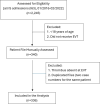Endovascular treatment in ischemic stroke with active cancer: retrospective analysis of university stroke center data
- PMID: 40383812
- PMCID: PMC12087119
- DOI: 10.1186/s42466-025-00392-1
Endovascular treatment in ischemic stroke with active cancer: retrospective analysis of university stroke center data
Abstract
Introduction: Active cancer (AC) associates strongly with ischemic stroke (IS). Intravenous thrombolysis (IVT) is often contraindicated in AC, and endovascular treatment (EVT) is considered the gold treatment standard, although data on its safety and efficacy is scarce.
Methods: Digital records of patients receiving EVT in a tertiary university hospital with comprehensive stroke center from 2016 to 2022 were assessed. Demographic, clinical, and laboratory parameters were extracted and compared between patients with and without AC. In-hospital mortality was set as the primary outcome.
Results: 39 AC and 297 non-AC patients were included. No significant differences were reported in demographic and baseline stroke parameters (NIHSS, mRS, stroke etiology). In-hospital mortality did not differ between groups (11/39 vs. 57/297, p > 0.99). Successful recanalization, change in mRS and NIHSS from admission to discharge, periinterventional complications, and stroke-related mortality were also comparable. Significantly fewer AC patients received IVT. In the binary logistic regression analysis (adjusting for confounder variables), older age, large artery atherosclerosis, unsuccessful recanalization, and higher admission NIHSS were independent predictors of all-cause in-hospital mortality (aOR): 1.04, 95% confidence interval (CI): 1.01-1.08; OR: 3.21, 95% CI: 1.03-9.92, OR: 7.28, 95% CI: 3.61-15.1, OR: 1.07, 95% CI: 1.01-1.14, p-value < 0.05, respectively).
Conclusions: EVT was shown as safe and effective in AC patients as in non-AC patients. Long-term functional outcomes are often poorer in AC, due to the cancer itself, but given how oncological treatment depends on functional status, AC patients should be considered for EVT.
Keywords: Cancer; Coagulopathy; Endovascular treatment; Ischemic stroke; Mortality; Thrombectomy.
© 2025. The Author(s).
Conflict of interest statement
Declarations. Ethics approval and consent to participate: The ethics committee of Ruhr-University Bochum approved this study (RUB Register Number 108 022 25352 7). Consent was not necessary. Competing interests: The authors declare that they have no competing interests in this section.
Figures
References
-
- Adams, H. P. Jr., Bendixen, B. H., Kappelle, L. J., Biller, J., Love, B. B., Gordon, D. L., & Marsh, E. E. 3rd (1993). Classification of subtype of acute ischemic stroke. Definitions for use in a multicenter clinical trial. TOAST. Trial of org 10172 in acute stroke treatment. Stroke, 24(1), 35–41. 10.1161/01.str.24.1.35 - PubMed
-
- Albers, G. W., Lansberg, M. G., Kemp, S., Tsai, J. P., Lavori, P., Christensen, S., Mlynash, M., Kim, S., Hamilton, S., Yeatts, S. D., Palesch, Y., Bammer, R., Broderick, J., & Marks, M. P. (2017). A multicenter randomized controlled trial of endovascular therapy following imaging evaluation for ischemic stroke (DEFUSE 3). International Journal of Stroke: official Journal of the International Stroke Society, 12(8), 896–905. 10.1177/1747493017701147 - PMC - PubMed
-
- Aloizou, A. M., Palaiodimou, L., Aloizou, D., Dardiotis, E., Gold, R., Tsivgoulis, G., & Krogias, C. (2023). Acute reperfusion treatment and secondary prevention of cancer-related stroke: Comprehensive overview and proposal of clinical algorithm. Therapeutic Advances in Neurological Disorders, 16, 17562864231180717. 10.1177/17562864231180717 - PMC - PubMed
-
- Caimano, D., Letteri, F., Capasso, F., Limbucci, N., Nencini, P., Sarti, C., Alemseged, F., Bigliardi, G., Morotti, A., Toni, D., Zini, A., & Arba, F. (2022). Endovascular treatment in patients with acute ischemic stroke and cancer: Systematic review and meta-analysis. Eur Stroke J, 7(3), 204–211. 10.1177/23969873221100897 - PMC - PubMed
LinkOut - more resources
Full Text Sources


